Steering Systems.
The rules regarding steering are quite simple.
Please note regulatory content below may be out of date. Please check the current Regulations for the latest information.
T12.1. Steering systems must have minimal play.
T12.2. Steering must be able to operate smoothly from lock to lock, without wheels making contact with bodywork.
T12.3. Steering must be by mechanical linkages only.
T12.4. Steering must be by front wheels only.
T12.5. Steering must be operable by hand only
However, as always, there are many ways to satisfy simple rules.
The first choice to make is what will the driver use to make the steering input? The main options are handlebars, joystick, “tank style” levers and steering wheel, and their popularity is in the same order with handlebars being by far the most common, all have their pros and cons.
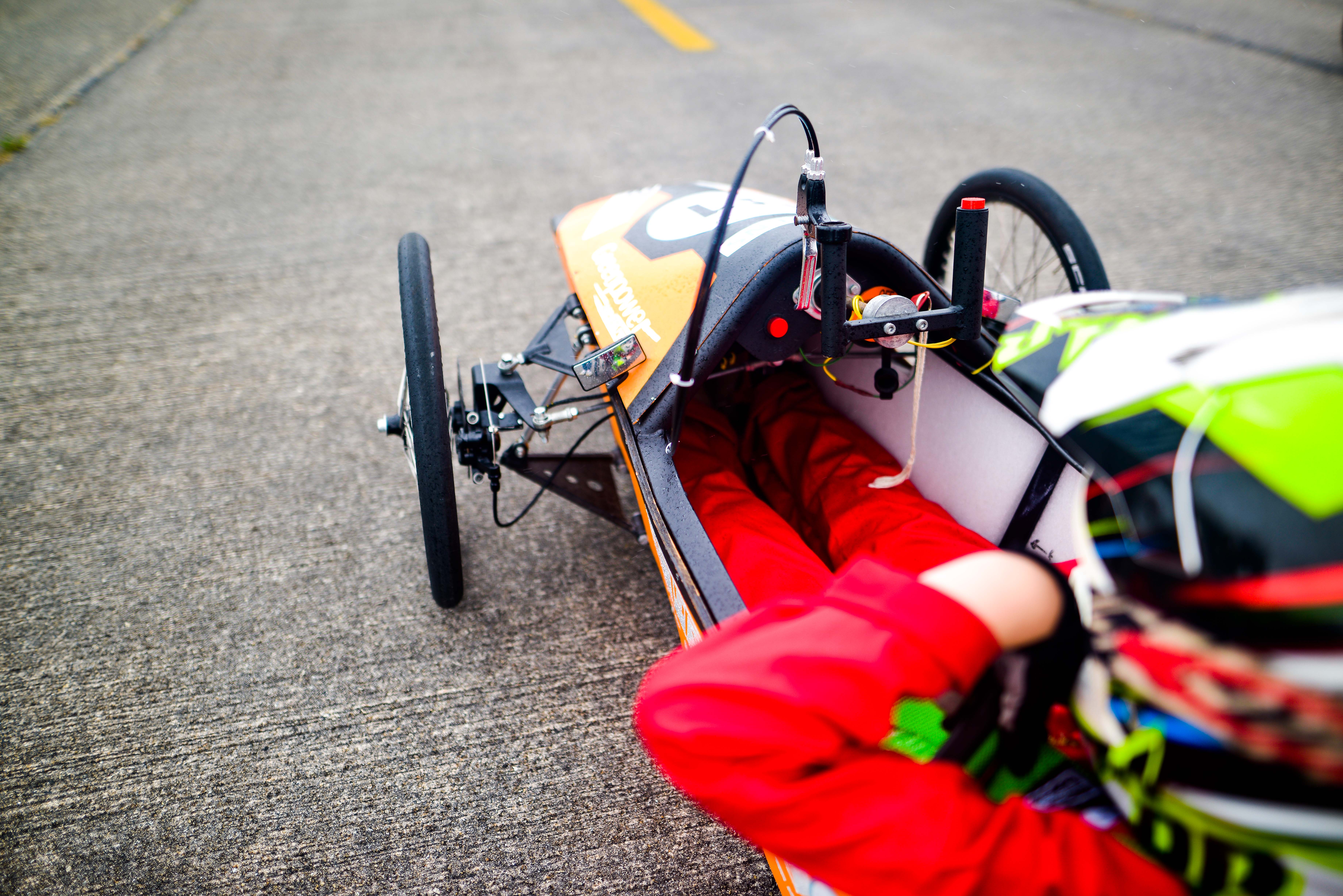
Handlebars
They include devices such as the Greenpower kit car steering wheel (pictured above), are the most natural instinctive to use which is an important consideration for novice drivers. They tend to take up more space at the top of the cockpit than other systems, so to allow acceptable driver access and prevent the handlebars contacting bodywork and/or driver during use the cockpit usually has to be higher than it would for other steering systems.
Joysticks
Most drivers don't find them as instinctive to use as handlebars but they have been used to good effect. The main advantage is the steering system can all be tucked away at the bottom of the cockpit allowing better access and in turn a lower side profile leading to better aerodynamics. The position of a joystick is less “universal” and usually some form of adjustment is necessary if a team has drivers of widely differing heights and a very reclined driving position.
Tank Levers
Two levers positioned one on either side of the driver and intuitively arranged such that pulling back on a lever results in the car turning in that direction. Has the advantage of potentially low side profile, is surprisingly natural in use and tends to fall easily to hand for all driver heights. More difficult to engineer than other methods.
Steering wheel
In a road car the steering wheel is connected to a steering rack in order to convert multiple turns into a linear movement, it allows a car to have a tight turning circle for parking and similar manoeuvres which simply isn't required of a Greenpower car. A steering wheel will tend to make access to the cockpit more difficult than necessary without offering any advantages over handlebars. It is very difficult to fit brake levers to a steering wheel.
Once you've decided how your car will be steered you need to connect that device to the steering hubs but always ensuring there is minimal play in the system whilst bearing in mind that the various steering arms will tend to move in all three planes. By far the simplest solution is to use track rods /tie rods made from threaded rod and rod end bearings, these are spherical bearings that allow a limited amount movement in all directions whilst being completely free of play.
A track rod is used to connect the arm on a steering column to the steering arm on the front hub, a car may have two track rods or just one track rod and a tie rod. A tie rod connects together both steering arms on the front hubs
Rod end bearings and threaded rod are both available in right and left handed thread, by combining both in a single track rod/tie rod it is possible to make accurate adjustment to the length of the rod without disconnecting either end. It is strongly recommended that the minimum size of rod end used in your steering is 8mm.
A note of caution, do not over tighten the bolt that passes through the rod end bearing, this can distort the bearing such that it binds and makes the steering very heavy.
Rod ends must always be secured with a locking nut. If no lock nut is used it will be impossible to eliminate play and there is a danger of the rod end becoming completely detached.
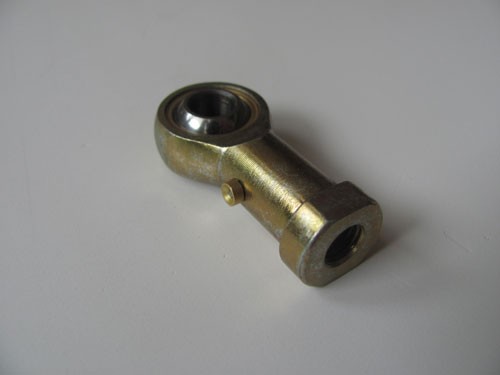
Most manufacturers state the threaded rod should be screwed into the rod end a minimum of 1.5 times its diameter, this equates to 10 threads for an 8mm or 10mm bearing and 9 threads for a 6mm bearing.
Steering Geometry
Before even contemplating the finer points of steering geometry you first need to decide how much the front wheels need to turn to get you round any corners you might reasonably expect to encounter during a Greenpower race. The two tightest corners in the Greenpower calendar are 6 metre radius at Ford Dunton and 15 metre radius at the Grampian Transport Museum, for a car with a typical 1400mm wheel base these will require steering angles of 14 degrees and 5.5 degrees respectively. The more steering angle your car has the more difficult it will be to steer smoothly and the steering will be heavier; so if you're not planning to race at Dunton the steering can be limited to around 10 – 12 degrees and the steering ratio (angle of input device compared to wheel angle) no lower than 2:1 i.e. if you turn the handlebars 10 degrees the front wheels should turn no more than 5 degrees.
There are three main angles to consider when setting up you steering.
Camber
When viewed from the front this is the angle of the wheel compared to the ground, the diagram shows a wheel with negative camber. Its purpose is to provide a more even tyre contact patch when the tyre is being distorted during cornering, road cars will have a small amount of negative camber and racing cars considerably more. Greenpower cars have a narrow contact patch and rarely corner hard so they do not require any camber, having the wheels as close to vertical as possible is also the most efficient.
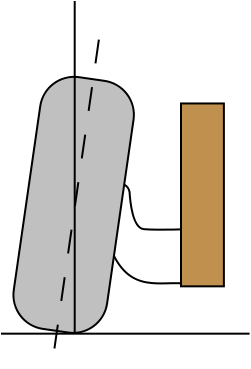
Caster Angle and Trail
The steering hubs should be designed so that the steering axis is at an angle such that it points downwards onto the road ahead of where the wheel touches the road. In the diagram below the distance between these two points is referred to a “trail”, on a Greenpower car this should be somewhere in the range of 20mm – 50mm. Trail provides stability to the steering and a self centring effect that makes holding a straight line much easier than if there were no trail, too much will make the steering heavy. Negative trail must be avoided, it is extremely dangerous as it tries to force the steering to full lock as soon as it is moved from the straight position.
It is not strictly speaking necessary to have the steering axis at an angle, trail can still be introduced by designing the steering hub so that the axle is behind a vertical steering axis, or you can use a combination of a small caster angle and inbuilt trail to achieve the desired mechanical trail.
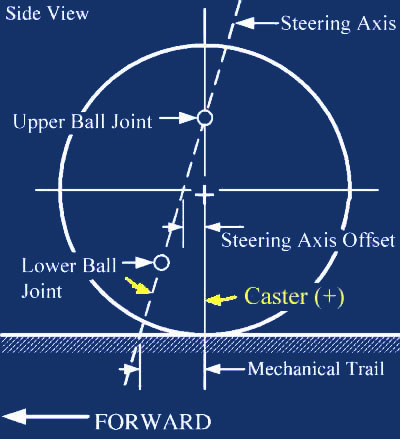
Credit - www.super7thheaven.co.uk
Kingpin Inclination, centre point steering and scrub radius
When viewed from the front a line drawn along the kingpin or, depending on design of the steering hubs, the upper and lower pivots will not be vertical but will be closer to the centre line of the car at the top than it is at the bottom. If that line is extended and meets the ground at the centre of the tyre then we have perfect centre point steering with zero scrub radius, this gives steering with the lightest weight and no reaction from bumps or braking. However perfect centre point steering can lack feel so it is often better if the car has 10mm – 15mm of scrub radius, this isn't enough to give excessive kickback from bumps but allows the driver to feel what the front wheels are doing.
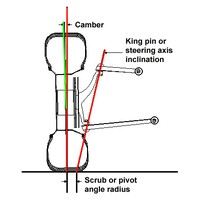
The SG1 project has a vertical kingpin with offset pivots to give a “virtual” kingpin angle, the pivots are also ahead of the axle to introduce trail.
Ackermann Angle
When steering around a corner the inner front wheel follows a tighter radius than the outer wheel and so must be turned through a larger steering angle. A simple way of achieving a close approximation to this is to arrange the steering hubs so that a line drawn through the steering pivot and tie rod pivot on the steering arm will meet the car's centreline at the rear axle. It isn't perfect but consider that, with the exceptions of Dunton and the Grampian Transport museum, a Greenpower car will rarely have a turn tighter that a 50 metre radius which requires a difference in angle between the front wheels of just 0.02 degrees; equating to only 0.1mm at the rim. Few, if any, teams can build to those sorts of tolerances so it's clear that the inbuilt inaccuracies in a steering system are likely to be much greater than those that may arise from not having effective Ackerman steering.
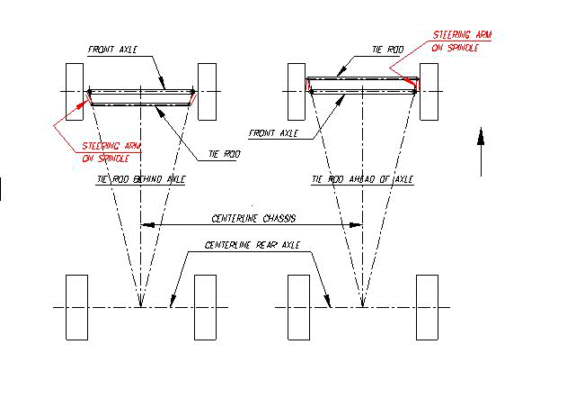
Credit - TomIII- Photobucket
- Gary Coulden-Smith